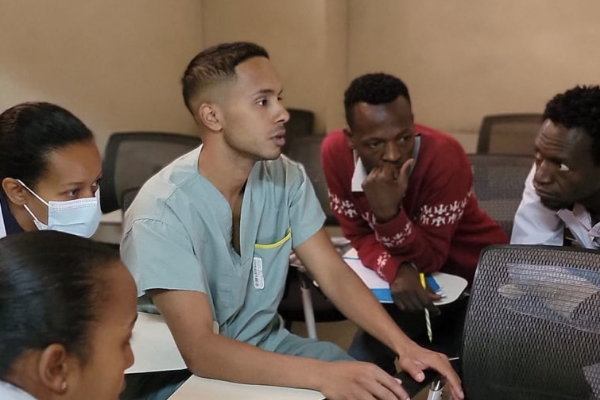New Pilot Program Better Links Patients at Home with Primary Care
Reta was one such individual: at the age of 94, she had a traumatic fall in her retirement home causing both of her ankles to fracture. She was then admitted to Southlake Regional Health Centre for care and later transferred to the reactivation care unit, which was designed to help patients transition to home.
During this time, Judy, a family member, advocated on Reta’s behalf to keep her stay at the hospital short. “Basically what Reta told me is, ‘I want to go home. I don’t care how, but I want to go home.’”
Fortunately, Reta was able to enroll in the Southlake@home program, a prototype program housed at the Southlake Regional Health Centre in Newmarket. Southlake@home is an innovative, population-based program that interconnects the hospital, home and community care, and primary care by providing patients with an intensive transitional plan of care from the hospital to their home. Through the program, patients who have completed a hospital stay in acute care will receive an intensive transitional care plan to ensure a smooth and safe journey home. The program works closely with primary care to ensure a patient’s family doctor is fully informed of the patient’s status once they are home and throughout the transitional period. This 16-week program is designed to bridge the gap between the hospital and the patient’s community by addressing not only the patient’s medical needs, but also providing support for mental health, addictions, and other social determinants of health.

Thanks to this program, Reta was able to return home for the remainder of her care. Her care coordinator and inter-disciplinary homecare team, led by a physiotherapist, supported Reta to reach her goal of being able to walk to the dining room. When the care team assessed a change in Reta’s condition, her primary care provider was notified of her condition and was able to implement changes to her care to prevent potential complications.
Since the program’s launch in March 2019, over 160 patients have been cared for and the program has received positive preliminary results for the patients, providers and the health system. Thanks to these preliminary results, the program has received funding for an additional 100 patients.
“The transition of information between the hospital, primary care, and the home and community care has been dramatically improved because there aren’t communication gaps that leave families feeling like they have to navigate the system on their own,” says Gayle Seddon, the lead of the Southlake@home program. “We’ve also found that prescriptions are being filled within 48 hours, patients are connected with primary care providers within seven days, and we have almost no patients returning to the emergency department within seven days of discharge for the same reason they were in the hospital.”
The interconnectedness between primary care, home care and the hospital is a key contributing factor to this outcome, says Seddon.
“We’re trying to go back to the success that primary care used to have with their relationships with the hospital,” says Dr. David Makary, Chief, Family & Community Medicine at Southlake Regional Health Centre and a DFCM faculty member. “The hospitals used to contact the primary care providers and let them know their patient has been discharged so they can follow up with them, give them all the necessary information, and have a high-quality visit following the discharge. This is something family doctors in our community have been wanting again for a long time.”
Moving forward, the Southlake@home team aims to leverage the program to help patients find family doctors. By collaborating with the Southlake Academic Family Health Team and other primary care providers in the area, the team hopes to learn how to do this successfully for both the patient and the provider.
“The Southlake Academic Health Team has taken in patients without a doctor. We hope that community connections formed through the Southlake@home program will also help patients without a family doctor find one close to their home, “ says Dr. Makary. “So we're working on building those relationships now.”
The program leads use continuous quality improvement methods to ensure the program is responsive to patients and providers, provides better clinical outcomes, and better outcomes for the healthcare system. What is learned will help inform how our Ontario Health Team can better serve our residents.
“Based on the success of the early results, we’re planning to leverage Southlake@home as one of the foundational elements in the Southlake Community Ontario Health Team,” says Seddon. “I think that being able to apply some of the key elements of this program to other populations such as the importance of communication between hospital, homecare and primary care will produce better health outcomes for individuals.”
News



